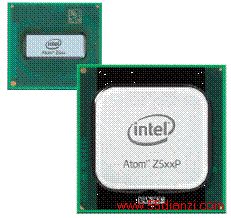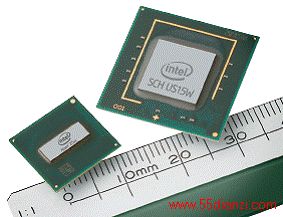Intel Atom Z2530和SH US15W多媒体手机开
Intel Atom Z2530和SH US15W多媒体手机开
点击数:7489 次 录入时间:03-04 12:03:21 整理:http://www.55dianzi.com 电工文摘
Intel 公司的Atom Z2530处理器耗散功率2.0W或2.2W,有多种设计应用. Atom Z2530基于45nm Intel架构,具有突破性功率管理性能,非常适合在对热量有严格控制和无风扇的嵌入式应用.而Intel的SCH US15W是低功耗高度集成的芯片组,包括有Intel GMA 500,存储器控制器,I/O控制器以及先进的3D图像和扩展的I/O功能如USB 2.0, SDIO和PCI Express,支持Intel高清Audio1和硬件视频译码加速, 400/533 MHz CMOS前边总线(FSB),两个独立显示器和2GB存储器.本文介绍了Atom Z2530和SCH US15W主要特性, 数字应用设计案例, Atom Z2530和SCH US15W开发板Crown Beach方框图以及Intel 媒体手机参考设计和主要元件列表.
The Intel System Controller Hub (SCH) US15W, available in two package sizes as well as both commercial and industrial temperature options, is a low-power, highly integrated chipset that addresses key requirements of thermally constrained and fanless embedded applications. It combines the Intel Graphics Media Accelerator 500 (Intel® GMA 500), memory controller, and I/O controller in a single-chip solution while featuring advanced 3D
graphics and extensive I/O capabilities such as USB 2.0, SDIO and PCI Express.* It supports Intel® High Definition Audio1 and hardware video decode acceleration, a 400/533 MHz CMOS front-side bus (FSB), dual independent display, and 2 GB max memory in a single channel with one or two ranks.
The Intel Atom processor Z5xx series provides a variety of design options with 2.0 or 2.2 watts thermal design power1 (TDP), two package sizes, and industrial as well as commercial temperature ranges. Based on 45nm Intel® architecture, these processors implement ground-breaking power management techniques, making them ideal for thermally constrained and fanless embedded applications.


图1. Intel Atom Z2530和SCH US15W外形图
These processors include embedded lifecycle support and remain software compatible with previous 32-bit Intel architecture and complementary silicon.
These single-core processors are validated with the Intel System Controller Hub US15W (Intel SCH US15W), available in two package sizes, which integrates the Intel Graphics Media Accelerator 500 (Intel GMA 500), memory controller, and I/O controller in a single chip.
The Intel® SCH US15W features advanced 3D graphics, hardware video decode acceleration, and Intel High Definition Audio2 along with extensive I/O capabilities, such as USB 2.0, GPIO, PATA, LPC, and PCI Express.* It also offers a choice of both industrial and commercial temperature ranges.
These two-chip platform solutions help developers create a product line with diverse sizes and thermal requirements for embedded market segments such as in-vehicle infotainment, industrial control and automation, gaming, medical, media phones, and retail and transaction solutions (i.e., kiosks, point-of-service terminals).
Product Highlights
Processor available in six options with variations in core speed, front-side bus (FSB), TDP, package size, temperature range and support for Intel Hyper-Threading Technology3 (HT Technology) See Table 2.
Intel’s hafnium-based 45nm Hi-k metal gate silicon technology reduces power consumption, increases switching speed, and significantly increases transistor density over previous 65nm technology.
Multiple micro-ops per instruction are combined into a single micro-op and executed in a single cycle, resulting in improved performance and power savings and higher scheduling efficiency.
In-order execution core consumes less power than out-of-order execution.
HT Technology (available in designated SKUs) provides high performance-per-watt efficiency in an in-order pipeline. HT Technology provides increased system responsiveness in multi-tasking environments. One execution core is seen as two logical processors, and parallel threads are executed on a single core with shared resources.
New C6 state (Deep Power Down Technology) removes power from processor core and caches, resulting in less leakage than C4 state. This technology is transparent to the operating system and meets existing mobile C-state exit latencies.
Split VTT rail removes power from ~90 percent of the I/O, reducing C6 state leakage and achieving a significantly lower idle power.
Utilizes CMOS drivers on many of the FSB signals for lower I/O power consumption.
Dynamic L2 cache sizing reduces leakage due to transistor sleep mode.
SSE3 instruction set enables software to accelerate data processing in specific areas, such as complex arithmetic and video decoding.
Enhanced Intel SpeedStep® technology reduces average system power consumption.
Execute Disable Bit4 prevents certain classes of malicious “buffer overflow” attacks.
Along with a strong ecosystem of hardware and software vendors, including members of the Intel® Embedded and Communications Alliance (intel.com/go/eca), Intel helps cost effectively meet development challenges and speed time to market.
Embedded lifecycle support protects system investment by enabling extended product availability for embedded customers.
Intel System Controller Hub (SCH) US15W
The Intel System Controller Hub (SCH) US15W, available in two package sizes as well as both commercial and industrial temperature options, is a low-power, highly integrated chipset that addresses key requirements of thermally constrained and fanless embedded applications. It combines the IntelGraphics Media Accelerator 500 (Intel GMA 500), memory controller, and I/O controller in a single-chip solution while featuring advanced 3D
graphics and extensive I/O capabilities such as USB 2.0, SDIO and PCI Express.* It supports Intel® High Definition Audio1 and hardware video decode acceleration, a 400/533 MHz CMOS front-side bus (FSB), dual independent display, and 2 GB max memory in a single channel with one or two ranks.
The Intel SCH US15W has a thermal design power2 (TDP) of 2.3 watts and is validated with the Intel Atom processor Z5xx series. This platform has a combined TDP under 5 watts and features embedded lifecycle support, making it ideal for many embedded market segments such as in-vehicle infotainment, industrial control and automation, gaming, medical, media phones, and retail and transaction solutions (i.e., kiosks, point-of-service terminals). The platform is also supported by the Intel Embedded
Graphics Drivers and video BIOS, developed specifically for embedded products and applications (developer.intel.com/design/intarch/ SWsup/graphics_drivers.htm).
Graphics and Display Intel GMA 500 is a flexible, programmable architecture that
supports shader-based technology, 2D, 3D and advanced 3D graphics, high-definition video decode, and image processing.
Features include screen tiling, internal true color processing, zero overhead anti-aliasing, programmable shader 3D accelerator, and 32-bit floating-point operations.
Dual display pipes with rotation support, along with low-voltage differential signaling (LVDS) and serial DVO (SDVO) display ports, permit simultaneous independent operation of one display or two. SDVO adapters provide interfaces to a variety of external
display technologies while the LVDS interface allows the Intel GMA 500 to communicate directly to a flat-panel display. The LVDS interface supports 18-bit or 24-bit color and EDID and EDID-less displays with a maximum pixel clock of 112 MHz.
[1] [2] 下一页
本文关键字:多媒体 手机 Intel 电工文摘,电工技术 - 电工文摘

